The King Fanless Intel Core i5 6x 2.5GbE CWWK System Internal Hardware Overview
Inside the system, we have a fairly familiar layout. There are M.2 slots on the top, SODIMMs on the opposite edge, and then the NICs on one side of the chassis. Below the M.2 SSD slot is another M.2 slot for WiFi NICs.
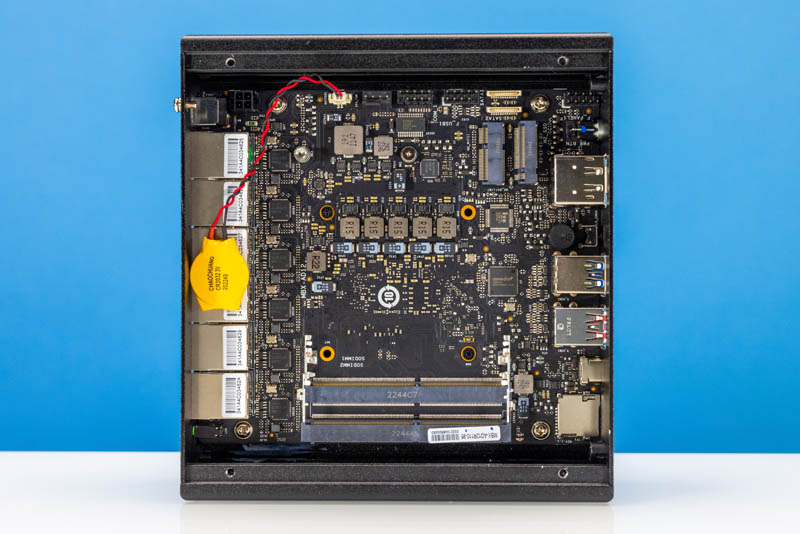
The NICs are Intel i226-V “SRKTU” chips. Something that is a bit different is that these NICs are on the SODIMM/ M.2 side of the chassis, not the CPU side. In many of the more recent fanless E-core only boxes we have seen them on the CPU side with a block to transfer heat to the chassis. The Intel i225-V was a 1.95W NIC while the Intel i226-V is 1.3W. Still, there are six of them so that is 7.8W TDP of NICs on the bottom side of the chassis.
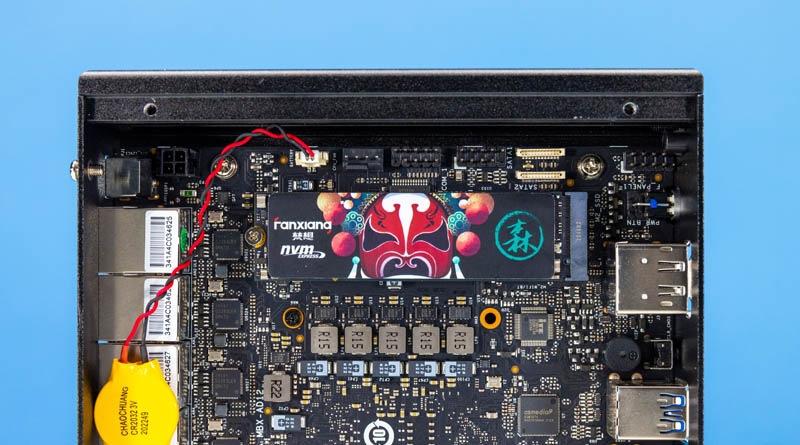
The included SSD was the Fanxiang drive that we have seen before such as in the Fanless 4x 2.5GbE Intel N5105 i226-V firewall we tested. The RAM was YueTiger 16GB DDR4-3200.
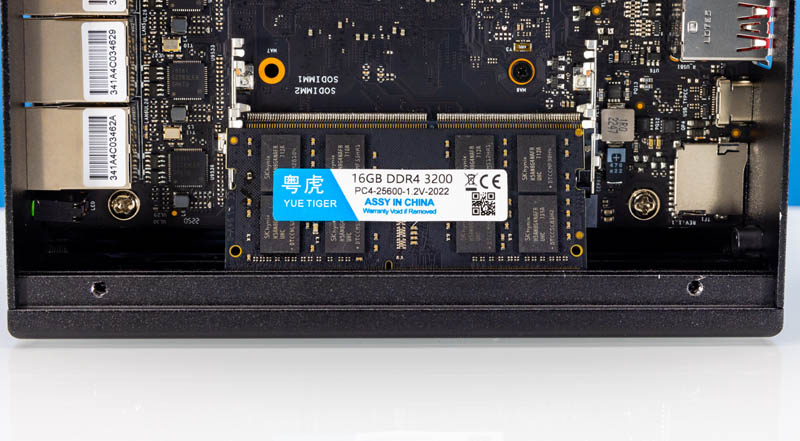
Since these systems can be picky on memory, these modules used the SK hynix H5AN8G4NAFR UHC 712A chips.
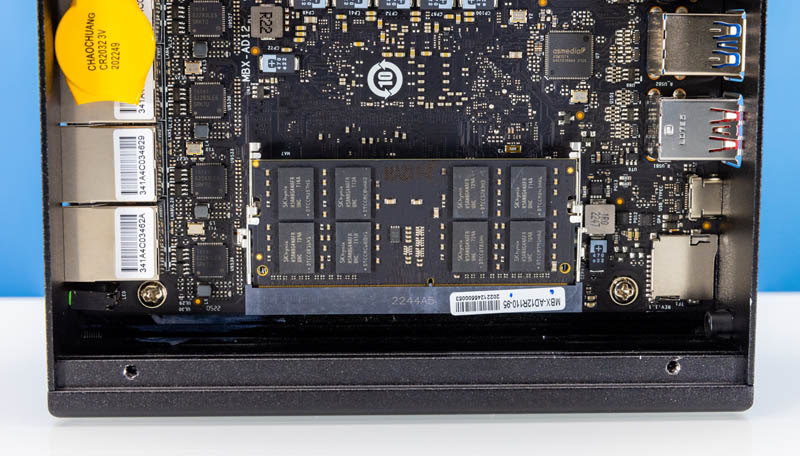
Here is the unit configured.
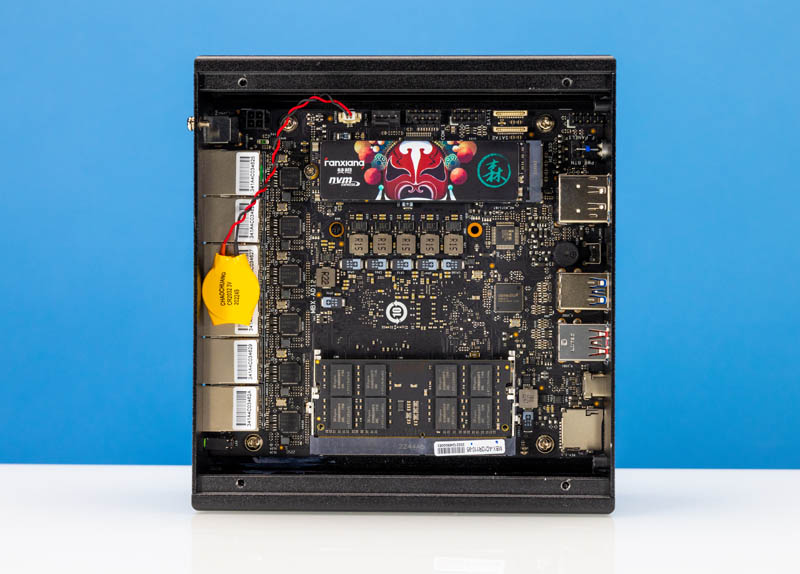
The Intel Core i5-1235U is on the opposite side of the motherboard. This chip has two P-cores with Hyper-Threading (2 cores/ 4 threads) plus eight E-cores (8 cores/threads) for a total of 10 cores and 12 threads.
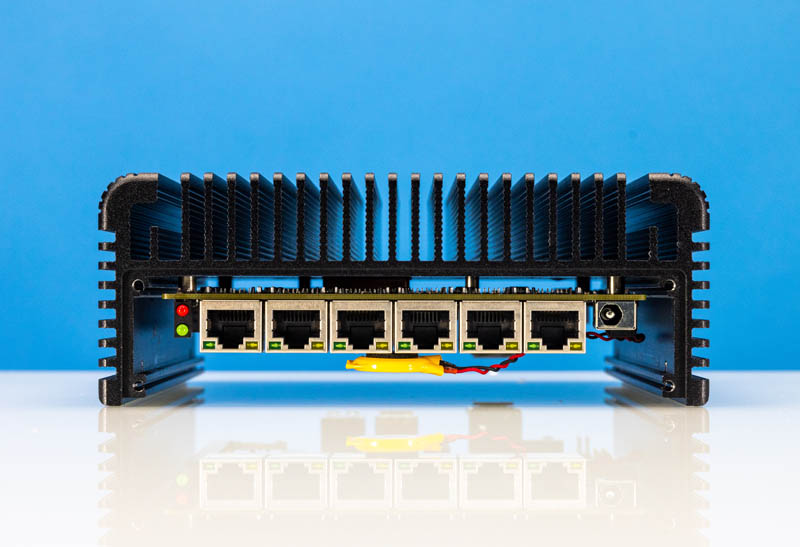
Contact between the chassis and the CPU was accomplished via a copper plate.
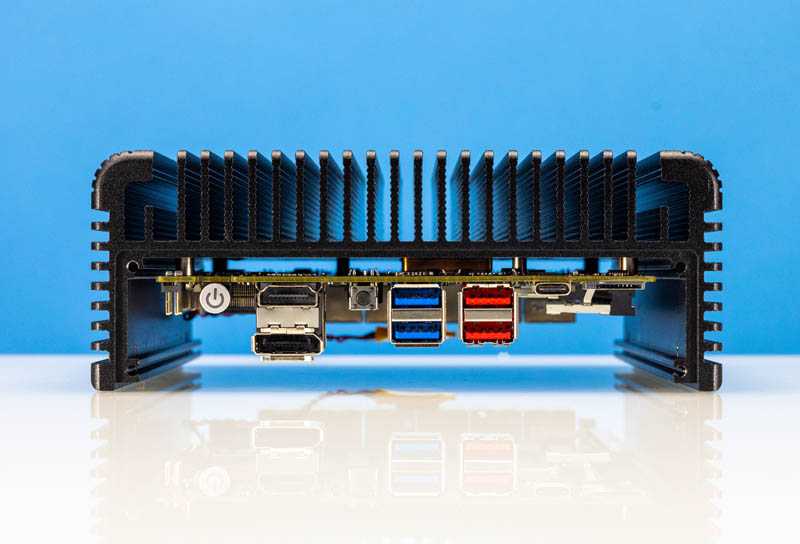
Overall, the cooling solution was making contact with the CPU in our unit, so temperatures were reasonable.
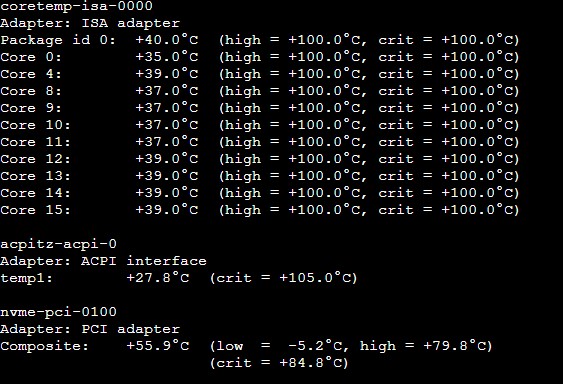
Our unit did not come with WiFi, but it is something we wished this unit had.
Adding WiFi 6/ 6E and BlueTooth
Adding WiFi on these is easier than when we first got them. The original BIOS on these was CNVio2 only. So we had an Intel AX210 WiFi 6E kit that we installed but it did not work. This was a feature added to the BIOS several weeks ago.
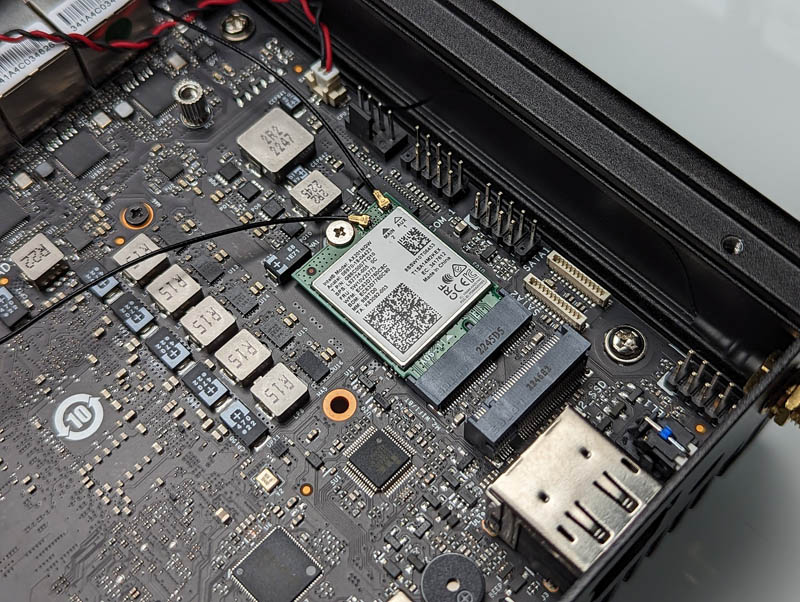
Still, we had the luxury of having an Intel AX201 CNVio2 WiFi 6 NIC handy, so we installed this using the antennas included in the PCIe bracket kit we purchased with the AX210.
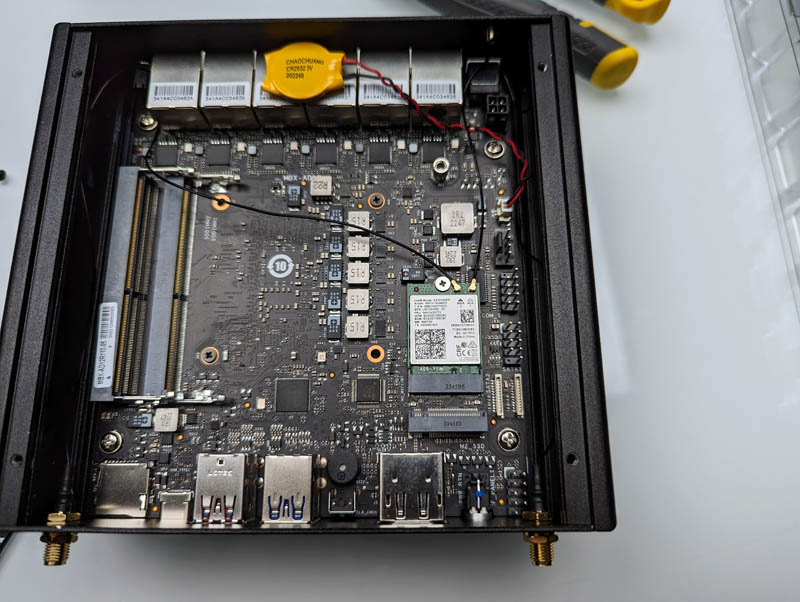
We routed the WiFi antenna leads through the plugs on the USB and display side of the chassis, and everything worked. The hardest part was getting the small MHF4 IPEX connectors attached to the WiFi. If you have good fine motor skills, then this is probably 1-2 minutes to install. If you have less than stellar fine motor skills, this will require more time and potentially a beverage.
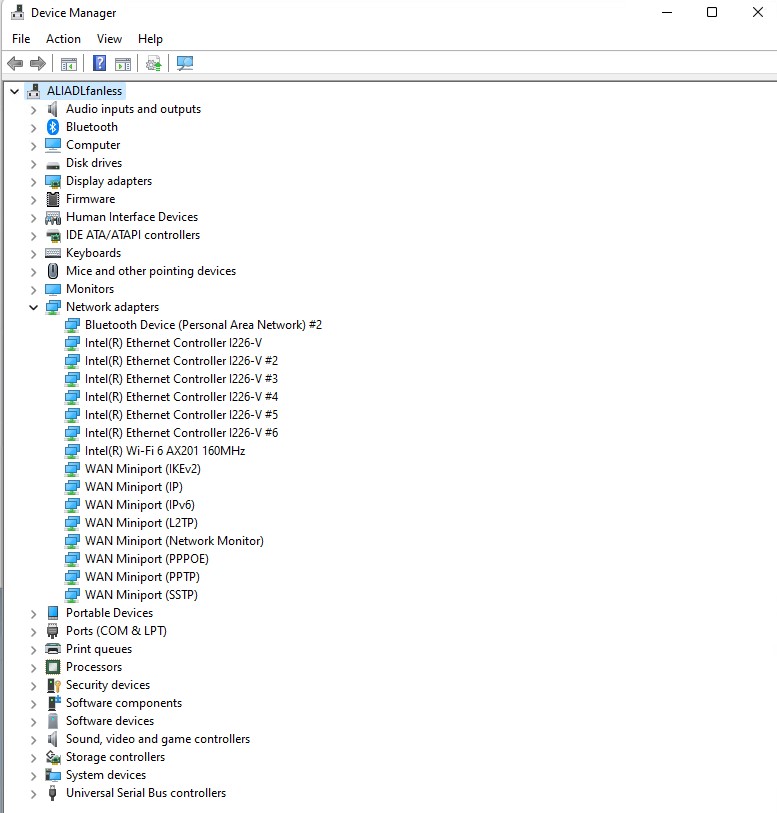
Once this was installed, we have our six Intel i226-V 2.5GbE NICs and a WiFi 6 + Bluetooth NIC working in our fanless machine.
Next, let us talk about the performance.




No testing of the max network throughput? It has six NICs so I’m sure folks are curious. I’m not expecting line rate but it’d be good to know where the ceiling is.
Huh? The N6005’s with four older E cores do line rate on 2.5GbE NICs if you’ve got dual ch mem installed. This is much faster than that.
Even with 64kB packets? All 6 NICs forwarding traffic at 2.5Gbps all at once? Maybe I’m just out of touch with what these CPUs are capable of.
“Something very cool.”
I see what you did there. Have an upvote.
vPRO Enterprise would make it really interesting.
You keep implying that the higher i7 variants won’t be worthwhile on TDP/heat limited designs, because they’ll just be throttled anyway… effectively killing the frequency advantage.
Sure, there will be diminishing returns, but as with all these mobile parts, in this case with the i5-1235U and the i7-1265U there, will still be a significant performance difference–at the very same TDP or heat point.
The difference between the two is no longer just Intel cutting certain fuses to provide a spread for every niche in the market (not that that’s gone away completely). At least part of it is really just binning and that’s really rather analog these days and not just about transistors working or not or chips failing to function beyond a certain speed.
While that can obviously happen, binning is mostly about the quality and impedance of wire-transistor interconnects and how they’ll require a bit more voltage (or not) to push signals at a given frequency. And of course, higher voltages imply higher power consumption, which also has chips failing eventually, but it’s the power budget that seems to be the more significant hurdle for binning.
E.g. in Skylake/Kaby-Lake times hyperthreading wasn’t cut for some bins because some transistors weren’t working, but mostly because it helped keeping the power budget in check. Real chip defects on the other hands could “crater” cache SRAM banks or full cores, so these i3-1215U could really be that type of salvaged chips—or require 30 Watts to run with fully enabled cores: too high to sell in a mobile space for 2P performance.
A lot of these i5-1235 might have no issue reaching “i7-1265 frequencies” or in fact higher yet, but they’d get hotter in comparison and at a certain point too hot for the platform constraints.
So on a mobile platform, those i7 will generally get you more overall compute out of the same battery power as well as a bit more peak, while on a passive heat constrained platform it’s more about the level and the length at which peak and sustained performance can be maintained.
Paying more for the i7 will almost certainly give you more performance in one way or another, than what you can get on the i5. Whether that those additional Hertz justify the extra $$$ is mostly a personal question, not technical.
I tend to re-purpose hardware; few systems ever get to serve out their life-time in the very use case for which they were bought. So, for me to aim a little higher on the parts isn’t a guaranteed waste, but often an opportunity to remain usable on a new job. It obviously doesn’t mean I’ll always aim for the top spot, either, or only when prices have stopped being crazy.
The most extreme examples of how far binning could spread from my past personal experience where Yorkfield/Harpertowns Quad-Cores, which Intel made around 2007/8 in a shrink of the 65nm designs to 45nm. Early Q9550 (2.83GHz) didn’t actually do much better than their Q6600 65nm (2.66GHz) predecessors, both balked at being pushed to the then magic 3 GHz, mine got hot and failed very quickly, others were luckier.
I had plenty of these for my kids so when I was hunting for a cheap way to extend the platform’s life-time I found Xeon X5492 being sold off for a pittance as well as ways to have LGA 771 chips fit into an LGA 775 socket (+ BIOS patches to make them work).
These Xeons were the truly golden sample Harpertowns/Yorkfield chips, the very best bin ever made on that 45nm process and even proclaimed that on their CPUID. While their official rating was 150 Watts of TDP, quite a lot for that socket at the time, they never came near that power consumption. Instead, they ran a very cool 50 Watts on Prime95 loads and reached 3.4 GHz and 1.6GHz FSB without breaking even a sweat on a box cooler.
They were mostly identical to the Core 2 Extreme QX9775, which officially only ran at 3.2 GHz also with 150 Watts of TDP, but that had an unlocked multiplier allowing them to complete Prime95 at 4GHz with some overclockers out there.
The gap between my first Q9550 which refused to do 3 GHz and those golden samples was more than 40%, which is why the industry then went into Turbo mode and monetized those bins to the utmost.
Are these 6 NICs bonded together which typically will result in better switching performance? Or are these all having to go through the CPU in order to move LAN traffic between ports? It looks like they’re all wired to the CPU, which kinda sucks for performance. I know you’ve recently reviewed some similar NUCs that have their LAN ports all wired up together to offload traffic from the CPU, but I don’t think any of them were 2.5Gbe based.
Thanks!
Justin C.
It looks to me that the advantage of the i7-1265U is V-Pro because the support of AMT, which means out-of-band management, but I guess this needs some support from the BIOS. Anyone tested that from any of those Aliexpress products?
Anyone got a problem with the power connector from those Aliexpress products, that just touching a bit the connector of the power supply, the computer gets reset? Returning the product for something that looks simple to solve will be pity!
I have this one for my lab I was running pfsense on it but it became to much of a headache so now I’m playing around sure a proxmox ve server on it. Currently running home assistant and Nas storage. I was going to is it as a router but now I just use it to play and around with. Thinking about installing windows 11 pro on it and utilizing hyper v. I attempted to install esxi but was having trouble with the big little architecture. I tried editing the install to prevent kernel panic with no luck.